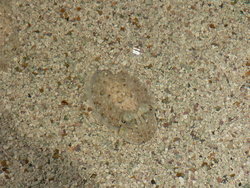Cuttlefish
|
|
| Cuttlefish | ||||||||
|---|---|---|---|---|---|---|---|---|
| Missing image Cuttlefish.jpg A Cuttlefish seen in profile A Cuttlefish seen in profile | ||||||||
| Scientific classification | ||||||||
| ||||||||
| Families | ||||||||
Cuttlefish are animals of the order Sepiida, and are marine cephalopods, small relatives of squids and nautilus.
Cuttlefish have an internal shell, large eyes, and eight arms and two tentacles furnished with denticulated suckers, by means of which it secures its prey. The name is sometimes applied to dibranchiate cephalopods generally.
Cuttlefish are caught for food, though squid is more popular. They are probably best known today for the shoehorn shaped piece of tough material given to parakeets as a bill-sharpener and source of dietary calcium. Called the cuttlebone, it is composed of calcium carbonate and is porous to provide the cuttlefish with buoyancy.
Cuttlefish are sometimes called the chameleon of the sea because of their remarkable ability to rapidly alter their skin color. Their skin flashes a fast-changing pattern as communication to other individual of the same species, as well as serving as camouflage from predators.
Cuttlefish have ink, like squids. This ink was formerly an important dye, called sepia. Today artificial dyes have replaced natural sepia.
Cuttlefish eat small molluscs, crabs, shrimp, fish and other cuttlefish. Their predators are sharks, fish, and other cuttlefish. They live about 1 to 2 years.
Like octopuses, cuttlefish have been successfully raised as pets in home aquariums, though even their bare necessities are significant. In particular, cuttlefish need a minimum amount of sea water in proportion to their body size, their tank needs to be cleaned every time they ink, they cannot tolerate abrupt changes in light levels, and they cannot coexist with other animals, and rarely ever with other cuttlefish. All other animals of comparable or smaller size, including other cuttlefish, are instinctively seen as food.
Domestic cuttlefish are very reminiscent of domestic cats, even exhibiting cat-like habits such as resting, pouncing on moving prey, begging owners for food, and even begging for more food than they need or is healthy for them. Like cats, cuttlefish are not truly tame, but rather tolerate and cooperate with their owners to live a comfortable life. But unlike cats, cuttlefish will try to eat other cuttlefish.
Classification
There are 119 species currently recognised, grouped into 5 genera. Sepiadariidae contains seven species and 2 genera. All the rest are in Sepiidae.
- CLASS CEPHALOPODA
- Subclass Nautiloidea: nautilus
- Subclass Coleoidea: squid, octopus, cuttlefish
- Superorder Decapodiformes
- Order Spirulida: Ram's Horn Squid
- Order Sepiida: cuttlefish
- Family Sepiadariidae
- Family Sepiidae
- Order Sepiolida: bobtail squid
- Order Teuthida: squid
- Superorder Octopodiformes
- Superorder Decapodiformes
See Also
Whyalla, South Australia: "Cuttlefish capital of the world"
External links
- Cephbase entry with full species list (http://www.cephbase.dal.ca/spdb/genusgroup.cfm?Genus=Sepia)
- Cuttlefish Husbandry (http://www.dal.ca/~ceph/TCP/cuttle1.html) - cuttlefish as petsde:Tintenfische

